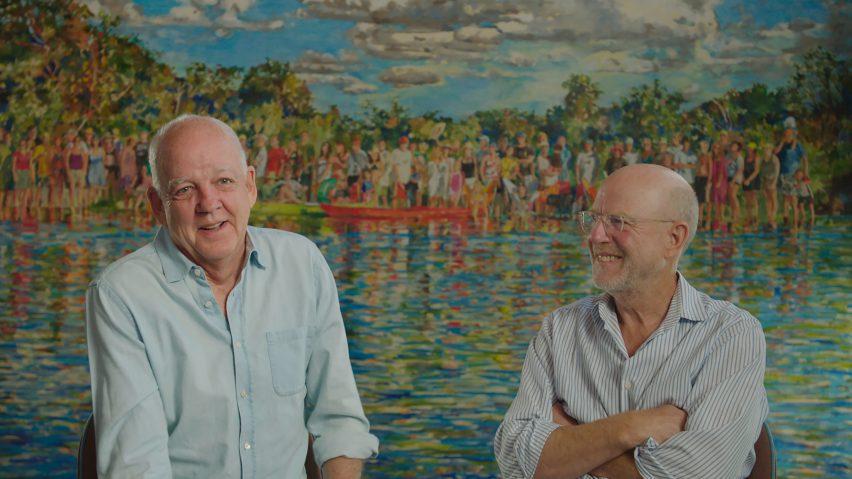AIA Gold Medal winners Ted Flato and David Lake share their views on how "architecture is being driven forward by a response to climate" in this exclusive interview.
Flato and Lake of Lake Flato Architects argue that in order to address the social and environmental issues of our time, architects must focus on regionalism to make buildings more sustainable and enjoyable for all species.
"We've moved beyond just the need for shelter, now's the time to shelter all species and think about the natural realm," David Lake told Dezeen.
"Architecture should intrinsically make us more connected to the natural realm; that goal is just something we live and breathe – and we love what we do."
Lake and co-medalist Ted Flato founded their studio, Lake Flato Architects, in San Antonio, Texas in 1984.
They have since completed projects ranging from stadiums to residences in 45 American states as well as in Mexico and the Caribbean.
The pair met after architecture school in the late 1970s as employees in the office of American architect O'Neil Ford, whose work attracted both men for its "regional modernism".
"When we both got out of architecture school in the late 70s, post-modernism was what was going on," Flato told Dezeen.
"And O'Neil's approach to modern regionalism was something that was all about craft and how one built; it was a great counterpoint to some of the popular things that were going on at the time."
Lake and Flato have continued this tradition, working closely with clients and institutions to create work that responds to and helps the environment – a philosophy spurred by both men's appreciation of the highly varied environment of the state of Texas, their home.
Indicative of this work are pavilions constructed in Texas to help protect and promote the health of watersheds.
The first, in Decatur, Texas was the first Living Building Challenge-certified project in the state. It implemented a complex water collection and treatment system in a relatively simple structure.
Lake said that this land-based approach should be applied as widely as possible, focusing on the unique needs of people, plants and animals in each.
"We need to move away from that international-style approach to architecture and think about how architecture is very much being driven forward by a response to climate," said Lake.
"When you respond to climate, when you use local resources, when you craft and merge both the art and architecture with the science of engineering, resource conservation and high-performance buildings that yields an architecture that isn't driven by form. It's driven by purpose, is driven by resilience."
Flato said that while a focus on locality is important, it's also important for architects to get out of their regions and be exposed to other conditions.
He added that a focus on longevity and output can be applied to a variety of situations and that architects can gain perspective by working in these different conditions.
Lake Flato has expanded on these environmental concerns, with projects that make buildings comfortable and sustainable in difficult environments.
In 2013, Flato led the charge on an expansive addition to the campus at Arizona State University that increased density and added landscaped elements to help students brave the heat. Lake said that this is still one of the studio's "best projects".
"Not only did we do an adaptive reuse of an old Air Force Base, but we made a place there in Arizona, where it's harsh; Ted managed to make everybody comfortable outdoors and convince the owners that all the corridors should be outdoors," Lake said.
"That's part of what we do. We try to find pathways that connect people to their place, and also think about the future," he added.
Beyond dealing with ecosystems, the studio has also engaged in work that engages the flow of goods and services over a wider supply chain.
Notably, the studio worked with climate organisation the Rocky Mountain Institute to make a series of grocery store chains H-E-B in Texas and Mexico more energy efficient in both operation and in their supply chain.
The studio has also worked on large-scale projects, such as an NBA stadium in San Antonio, which they said was an interesting project in that it proved they could scale up their regionally oriented, sustainable approach.
"One of the really exciting aspects of the work we get to do is just the range of work that we get to work on the range of places and programs," said Flato.
"Ultimately we're problem solvers and we like to have new and interesting problems."
Lake and Flato both said they were honoured to receive the AIA Gold Medal, the highest award bestowed by the American Institute of Architects.
The duo was awarded the 2024 AIA Gold Medal for their engagement with "controversial environmental and socio-political issues".
"We felt that in the beginning that buildings could make people more connected to the environment," said Lake. "What an honor to have our peers recognize our 40 years of effort to do that."
Other projects by Lake Flato include residences such as a Corten-steel-clad house in Texas that was designed to "sit lightly on the land", an education center in Mississippi built on a site destroyed by Hurricane Katrina and a house with 3D-printed elements in Austin.

